Hog Hunting – The Off Season Solution
By Mike Daniecki
I'm sure the rest of you can agree, there is a very distinct and empty feeling at the end of any big game season. There is also an unequivocal sense of impatience as we gear up and wait for the next one to arrive. Fortunately for me, Texas has no closed seasons on wild hogs, limiting the aforementioned anxieties and feelings of emptiness. If your state affords you the same type of open season, I would urge you take advantage of it.
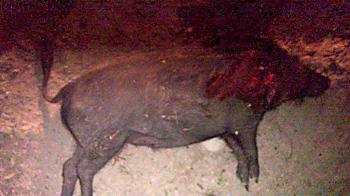
Mike Daniecki. Big Sow. 24 July 2011. 36% Moon.
As with any type of hunting, I suffered initial failures, so I took to the internet for solutions. I found the usual tips and tricks, attractants, baits, habits, etc. Nothing that I would consider ground breaking news or secrets. Several years in the field chasing these wild hogs has led me to my own conclusions on these subjects.
First and foremost, these creatures are driven by appetite. If there is a food source, there are hogs. Now you're left with catching them on the food, which we will discuss at a later time. The type of food source really seems irrelevant with the successes that I have observed. Corn feeders, protein feeders, fruit piles, buried attractants, and oat fields have all been equally successful. (in the proportions that I have hunted them). Corn is my preferred bait, simply based on price.
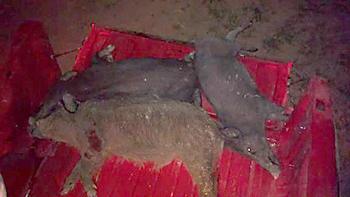
3 fields, 3 hogs. Hat trick. 01 Sept.2011. 18% moon.
Strong arguments exist that a hog must smell the bait in order to find it, thus leading to the necessity of mixing corn with another attractant. I have mixed corn with cherry Kool Aid following this principal, and have not seen any greater success due to the sweet smelling mixture. There is no doubt in my mind that a hog needs to smell bait, after all, they have an amazing nose. However, they are nomadic and they are constantly traveling, looking for new food sources. I offer you this: A line of corn, dribbled perpendicularly from a truck or four wheeler across an area where hogs travel, will stop any hog with a nose. They can't help but smell it then, and you've stopped them at a place of your choosing.
Although not my favorite technique, I will occasionally stand hunt over corn and protein feeders while scouting my preseason deer. It gives me an opportunity to take some pictures, monitor my antler growth, and of course, put some meat on the table.
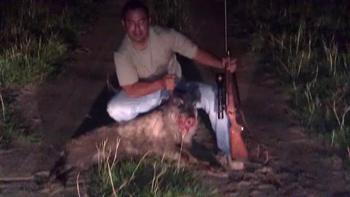
Francisco Salazar. 14 June 2012. 21% Moon.
When the weather cools down, I really enjoy spotting and stalking in the pastures and food plots. This is an excellent opportunity to get a youngster in the field. I have found that a stalk on preoccupied hogs, is far more forgiving than that of deer. As long as the wind is in your face, and you are reasonably slow in your movements, you can get within bow range relatively easily. They smell and hear with the best of the deer, but their eyesight is lacking, making them a perfect quarry for young hunters and novices looking to sharpen their skills. I have low crawled across a freshly planted oat patch, to get a 100 yard shot on a group of six hogs. I wear camo, or jeans and a t-shirt, and they don't seem to mind.
Finally, there is the spotlight technique. The dog days of summer tend to find me hunting in this fashion. I place my corn lines as mentioned above, wait for the sun to set, and run my areas in the truck or buggy while shining the fields, trails, and pastures. Now I will disclose a secret for this particular method of hunting. Last year, we killed around 100 hogs while spotlighting. Some nights we killed 3 or 4, and some nights we couldn't even get a glimpse of one. That's hunting right? That's what we chalked it up to until I recalled a conversation at a deer camp some time ago. There was a fellow there who swore by the Farmer's Almanac. He followed it to the "T", and wouldn't get into the stand until the time specified by this holy book.
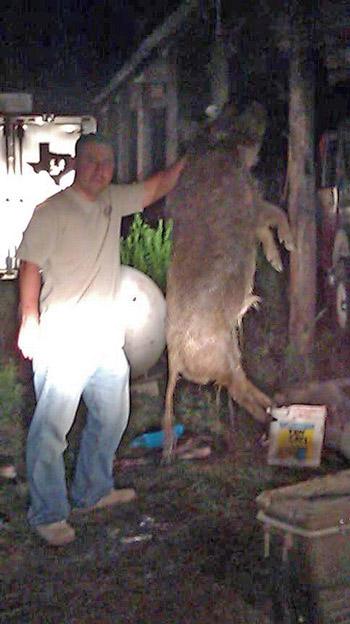
Francisco Salazar.
One unsuccessful night, over a late night breakfast at Denny's, we began to discuss our tactics and what characteristics we could recall from our many successful hunts. The question of moon phase is asked again. A brief Google search yielded this web site: http://www.almanac.com/moon/calendar/TX/Houston/2012-07
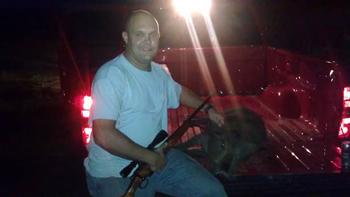
Mike Daniecki. 29 Sept. 2011. 7% Moon.
I referenced the dates of the photos I had of all of our successful hunts by spotlight in the last 2 years. They all had one thing in common; little or no moon light. We had not killed a single hog when the moon was above 39% full. I now hunt by spotlight exclusively using this principle, and have not come up empty handed yet when using corn lines this summer. Foolproof? I'm sure it's not, but I have not yet been able to disprove this to myself. I am also finding, (not as solidly as the spotlight moon phase) that the kills I have made in the morning time, have come after a full, or mostly full moon the night prior.

My son Michael's first hog hunt.12 Nov. 2011 99% moon the night prior. Killed at 8:30 a.m.
The necessary gear to hunt hogs is about the same as hunting deer. One thing that is a must is a sharp knife. I bring 3, and a sharpener. The hair on these hogs is extremely coarse, and will make a butter knife out of D2 steel that started with a razors edge.
Caliber selection for taking these critters is endless, and harshly debated. I've killed them with everything from a 22 WMR to a 7mm Remington Mag. The "ideal cartridge" I will leave to be figured out by the continuing and opinionated debate found on the message boards. It has been my experience that proper shot placement, (behind the shoulder or in the ear) by a 6mm Remington, shooting a 100 gr. Hornady soft point has never lost me a hog.
Happy hunting, good luck, and take a kid with you on your next trip afield.
I would like to extend a very gracious thank you to Mr. Duane Corley, for the access to his ranch he has afforded me, and the memories made with each trip hunting there.
By Mike Daniecki
I'm sure the rest of you can agree, there is a very distinct and empty feeling at the end of any big game season. There is also an unequivocal sense of impatience as we gear up and wait for the next one to arrive. Fortunately for me, Texas has no closed seasons on wild hogs, limiting the aforementioned anxieties and feelings of emptiness. If your state affords you the same type of open season, I would urge you take advantage of it.

Mike Daniecki. Big Sow. 24 July 2011. 36% Moon.
As with any type of hunting, I suffered initial failures, so I took to the internet for solutions. I found the usual tips and tricks, attractants, baits, habits, etc. Nothing that I would consider ground breaking news or secrets. Several years in the field chasing these wild hogs has led me to my own conclusions on these subjects.
First and foremost, these creatures are driven by appetite. If there is a food source, there are hogs. Now you're left with catching them on the food, which we will discuss at a later time. The type of food source really seems irrelevant with the successes that I have observed. Corn feeders, protein feeders, fruit piles, buried attractants, and oat fields have all been equally successful. (in the proportions that I have hunted them). Corn is my preferred bait, simply based on price.

3 fields, 3 hogs. Hat trick. 01 Sept.2011. 18% moon.
Strong arguments exist that a hog must smell the bait in order to find it, thus leading to the necessity of mixing corn with another attractant. I have mixed corn with cherry Kool Aid following this principal, and have not seen any greater success due to the sweet smelling mixture. There is no doubt in my mind that a hog needs to smell bait, after all, they have an amazing nose. However, they are nomadic and they are constantly traveling, looking for new food sources. I offer you this: A line of corn, dribbled perpendicularly from a truck or four wheeler across an area where hogs travel, will stop any hog with a nose. They can't help but smell it then, and you've stopped them at a place of your choosing.
Although not my favorite technique, I will occasionally stand hunt over corn and protein feeders while scouting my preseason deer. It gives me an opportunity to take some pictures, monitor my antler growth, and of course, put some meat on the table.

Francisco Salazar. 14 June 2012. 21% Moon.
When the weather cools down, I really enjoy spotting and stalking in the pastures and food plots. This is an excellent opportunity to get a youngster in the field. I have found that a stalk on preoccupied hogs, is far more forgiving than that of deer. As long as the wind is in your face, and you are reasonably slow in your movements, you can get within bow range relatively easily. They smell and hear with the best of the deer, but their eyesight is lacking, making them a perfect quarry for young hunters and novices looking to sharpen their skills. I have low crawled across a freshly planted oat patch, to get a 100 yard shot on a group of six hogs. I wear camo, or jeans and a t-shirt, and they don't seem to mind.
Finally, there is the spotlight technique. The dog days of summer tend to find me hunting in this fashion. I place my corn lines as mentioned above, wait for the sun to set, and run my areas in the truck or buggy while shining the fields, trails, and pastures. Now I will disclose a secret for this particular method of hunting. Last year, we killed around 100 hogs while spotlighting. Some nights we killed 3 or 4, and some nights we couldn't even get a glimpse of one. That's hunting right? That's what we chalked it up to until I recalled a conversation at a deer camp some time ago. There was a fellow there who swore by the Farmer's Almanac. He followed it to the "T", and wouldn't get into the stand until the time specified by this holy book.

Francisco Salazar.
One unsuccessful night, over a late night breakfast at Denny's, we began to discuss our tactics and what characteristics we could recall from our many successful hunts. The question of moon phase is asked again. A brief Google search yielded this web site: http://www.almanac.com/moon/calendar/TX/Houston/2012-07

Mike Daniecki. 29 Sept. 2011. 7% Moon.
I referenced the dates of the photos I had of all of our successful hunts by spotlight in the last 2 years. They all had one thing in common; little or no moon light. We had not killed a single hog when the moon was above 39% full. I now hunt by spotlight exclusively using this principle, and have not come up empty handed yet when using corn lines this summer. Foolproof? I'm sure it's not, but I have not yet been able to disprove this to myself. I am also finding, (not as solidly as the spotlight moon phase) that the kills I have made in the morning time, have come after a full, or mostly full moon the night prior.

My son Michael's first hog hunt.12 Nov. 2011 99% moon the night prior. Killed at 8:30 a.m.
The necessary gear to hunt hogs is about the same as hunting deer. One thing that is a must is a sharp knife. I bring 3, and a sharpener. The hair on these hogs is extremely coarse, and will make a butter knife out of D2 steel that started with a razors edge.
Caliber selection for taking these critters is endless, and harshly debated. I've killed them with everything from a 22 WMR to a 7mm Remington Mag. The "ideal cartridge" I will leave to be figured out by the continuing and opinionated debate found on the message boards. It has been my experience that proper shot placement, (behind the shoulder or in the ear) by a 6mm Remington, shooting a 100 gr. Hornady soft point has never lost me a hog.
Happy hunting, good luck, and take a kid with you on your next trip afield.
I would like to extend a very gracious thank you to Mr. Duane Corley, for the access to his ranch he has afforded me, and the memories made with each trip hunting there.

